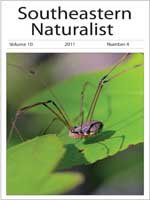American Alligator (Alligator mississippiensis) food habit data are important when establishing management strategies, as diet can directly influence growth rates, body condition, behavior, and reproduction. Diets of American Alligators are hypothesized to vary among habitats as well as geographically; however, few diet studies have been conducted outside of Florida and Louisiana. To address this information gap, 62 diet samples were obtained from alligators ranging in size from 94.7 cm to 386.0 cm (total length) from June 2006–September 2008 in inland freshwater wetlands in East Texas. A total of 33 different prey items (comprising 670 individual prey items) and 1 parasite were identified. Irrespective of size class, sex, and study site, >85% of individual prey items were invertebrates. Nearly all diet samples contained some sort of organic by-catch and/or non-food items (i.e., woody debris, aquatic plants, seeds, rocks, fishing tackle, etc.). Although alligator diets were similar between sexes, non-breeding (<183.0 cm in total length) alligators consumed more invertebrate prey items by biomass and percent occurrence than breeding-size alligators. In general, alligators forage opportunistically; therefore, most habitat-based, local, or geographic variability in food habits among populations are most likely influenced by food availability. As such, regional differences in food availability likely result in geographic variability in life-history characteristics such as growth rates and condition, important factors to consider when establishing management strategies.
How to translate text using browser tools
1 December 2011
Food Habits of American Alligators (Alligator mississippiensis) in East Texas
David T. Saalfeld,
Warren C. Conway,
Gary E. Calkins
ACCESS THE FULL ARTICLE

Southeastern Naturalist
Vol. 10 • No. 4
December 2011
Vol. 10 • No. 4
December 2011




